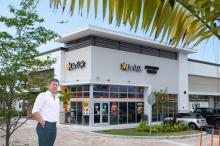Lower-than-average prices, alliances with the sports world and a sustainability strategy have led Score to position itself as a regional alternative to American and European energy drinks.
With the slogan "The extra energy you need", the Chilean energy drink brand Score Energy Drink has set out to disprove two myths: first, that only large multinationals offer energy drinks and also, that the exclusive public for these drinks are athletes.
When Patricio Pinto founded Score in 2011, he had in mind that in the modern world, the average person is taking on more and more responsibilities. A trend that is accompanied by less energy and therefore, a greater demand for products that help to finish the day successfully.
At that time, Pinto noticed that energy drinks were gaining popularity in Chile and other countries in the region, but they were mostly from multinationals that sold the cans at elite prices. Seeing that these products were escaping the reach of “ordinary people,” he decided to join forces with a German company to develop a drink formula for the Chilean market. Later, a design, brand and name were created to create the product, which was the origin of the business.
“Score was born out of the need and opportunity we saw in the Chilean market. So the Germans and Austrians, who designed the formula, were several years ahead of us in terms of this development. For them, a product like this was more accessible and they had access to market studies that helped us better understand the need that could exist in a region like Latin America, where there were no local brands,” declared Patricio Pinto, CEO of Score Energy Drink to AméricaEconomía .
Pinto acknowledges that the demand for energy drinks is not new, as historically, humans have turned to tea, coffee and Coca Cola to give themselves an extra boost. However, he says that energy drinks provide a differential value, because they contain compounds such as vitamin B and taurine, which have even more stimulating effects, appreciated by young people.
“Among the current generations, many have replaced their regular coffee consumption with energy drinks. And in turn, these have been adapted and lowered the levels of some ingredients that were previously aimed at athletes, such as glucono delta-lactone, caffeine or sugar. To such an extent that a 500cc can is now more or less equivalent to a double espresso,” explained Pinto.
HOW DID SCORE BECOME A POPULAR DRINK?
In this decade and a half of work, brand positioning has been the most challenging aspect for the Score team. Pinto says that the traditional channel, led by local stores and wineries, was their greatest ally in the first stage, because it allowed for greater communication between partners. Unlike supermarkets or department stores, the owners of distributors and wholesalers allowed for direct dialogue to explain the business proposal.
Originally in 2011, Score launched the drinks at $1,000 per can (US$1.05 or S/. 3.90 today), an affordable price compared to foreign brands, which offered their cans for twice as much. Over time, Pinto says the drink began to make inroads into the local market, thanks to this key difference. However, in the long run, growth lost momentum, because many people still resisted buying the drink: they believed that the low price raised doubts about the quality of the product.
It was then that Score launched a second offensive, this time based on mass marketing and the search for strategic partners. In this sense, football played a central role: the drink has sponsored teams in the First Division and matches of the Absolute National Team. When the ties with “La Roja” were strengthened, Pinto assures that people began to trust the brand more and many became loyal. In this way, Score has grown more than 100 times since its foundation and in 2024 alone, its sales increased by 15%.
“There are many brands that come into the market thinking in the short term, and that is where it is difficult for them, because in Latin America it is difficult to gain the trust of consumers and suddenly, they are more traditional markets that trust in what they have always bought for generations,” adds Pinto.
To make a difference, the executive says that sustainability is important through strategies such as using aluminum cans instead of plastic, as well as passing the cans through heat tunnels to reduce the impact of sodium benzoate on consumers. Although Pinto says that this focus on quality must be accompanied by high production volumes that allow selling at affordable prices.
PERU IS KEY
Score has taken this approach to its expansion in Peru, where it has partnered with distributor Jandy to expand through traditional channels and thus have a presence nationwide. Meanwhile, in the last month, an agreement was reached to sell Score cans in Peruvian supermarkets, which marks its arrival in modern channels, where it hopes to compete with local (Volt) and international (Red Bull) alternatives.
In fact, Peru is not just any market: in September 2024, the Statista Consumer Insights macro survey revealed that in this country, 30% of respondents indicated that they consume energy drinks regularly. The top 5 is completed by Brazil (29%), Chile (27%), Mexico (25%) and Colombia (23%).
Along the same lines, Euromonitor International's Energy Drinks in Peru 2022 study revealed that energy drink consumption grew by 14.5% between 2021 and 2022, as a result of Peruvians resuming pre-pandemic activities such as in-person work and sports.
According to Pinto, one of the main differences between the Chilean and Peruvian markets is that in Score's home country, energy drinks come in aluminium cans. In Peru, however, plastic bottles are also used for this type of product.
“In addition, in Chile, they have already become accustomed to the large 500cc can, the presentation that Score usually uses. And in Peru, we have seen different formats, whether small, medium or large. I think it is an interesting and dynamic market that also consumes energy drinks on a daily basis and where there is twice as much population as in Chile,” says Pinto.
On the other hand, both Chileans and Peruvians lean towards sweets, which is reflected in most of Score's seven flavors: original, mango, guarana, sugar-free, mojito, red fruits and bubble gum. Pinto does not rule out introducing flavors inspired by the taste of the average Peruvian.
“Part of our brand’s international focus is to design flavors that people in the area like. That is a flexibility that we have compared to brands that are much larger. Companies that decide at a regional level, but not in local terms. So we could develop a Chicha Morada Score if we see that three or four flavors of the drink are successful in the country,” he adds.
SUSTAINABILITY AND OTHER EXPANSION STRATEGIES
Another of the company's recent initiatives is a line of canned water: an unusual idea in Chile and Peru, although not without potential, because in the United States it is common and in Brazil, many restaurants are implementing it. Pinto says that it is part of the objective of reducing the use of microplastics in consumer goods. But since it entails higher production costs, the executive believes that it is a proposal that will take at least five years to compete with bottled water.
Score is also preparing for an ambitious goal: to break into the Brazilian market. This is a country with a large population, but with obstacles such as entry barriers and high import costs, which can make drinks more expensive. To solve this, Score aims to manufacture the drinks in the country, using the German formula. Pinto believes that between March and April, the first production would be ready, with emphasis on the city of São Paulo and its surroundings.
“There are markets like Brazil and Bolivia, where you have to change your mind in order to expand. Because they maintain protectionist economies, where if you import products, you start at a disadvantage with the taxes you have to pay,” warns Pinto, who hopes that in ten years, Score will have a presence throughout Latin America.
The first steps towards this goal are the registration of the brand in different countries in the region: Score is already registered in the USA, Argentina, Panama, Bolivia, Paraguay, Uruguay and Colombia in the American continent. In addition, in Europe, it is registered in Poland, Austria, Germany and Italy.
With a consolidated presence in Chile and promising progress in Peru, Score Energy is now preparing to face the challenge of conquering the Brazilian market. Its expansion strategy based on sustainability and innovation in flavors promises to make it a major player in the Latin American energy drinks market.









